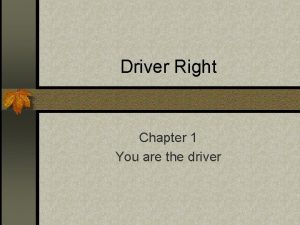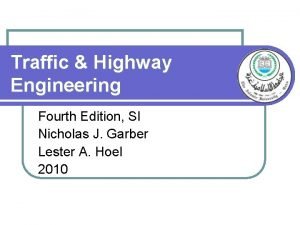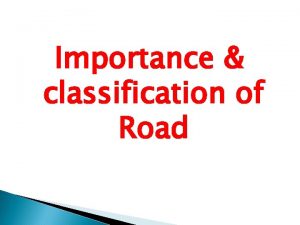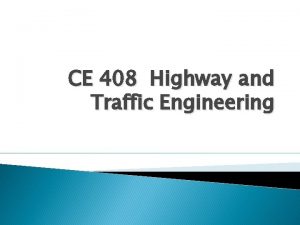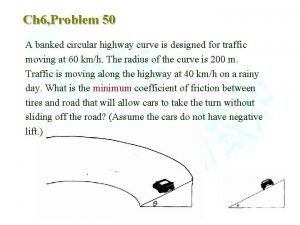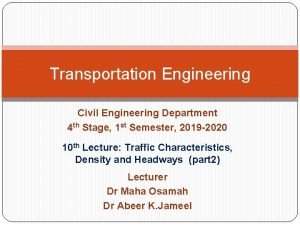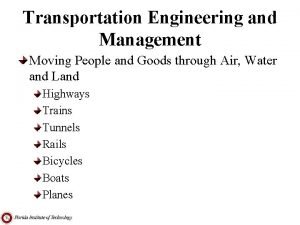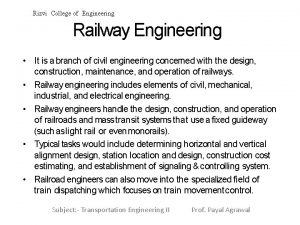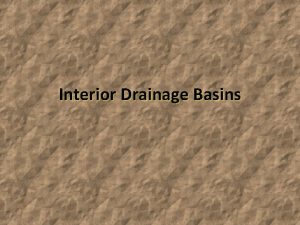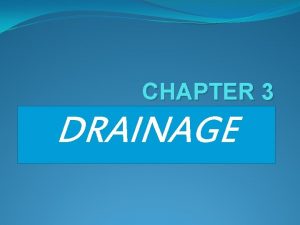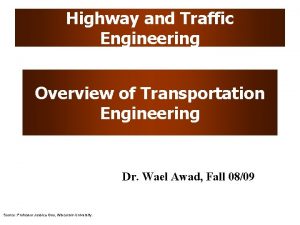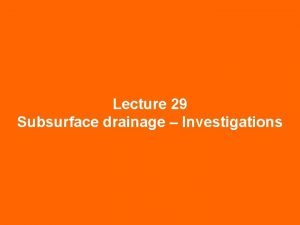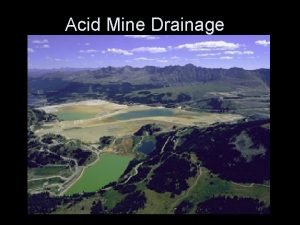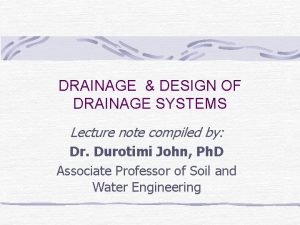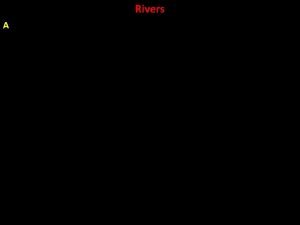PART 2 HIGHWAY DRAINAGE Transportation Engineering I HIGHWAY


















- Slides: 18

PART 2 HIGHWAY DRAINAGE Transportation Engineering - I

HIGHWAY DRAINAGE A means by which surface water is removed from pavement and ROW Redirects water into appropriately designed channels Eventually discharges into natural water systems

INADEQUATE DRAINAGE Damage to highway structures Loss of capacity Visibility problems with spray and retro-reflectivity Safety problems, reduced friction and hydroplaning

HIGHWAY DRAINAGE Transverse slopes � Removes water from pavement surface � Facilitated by cross-section elements (cross-slope, shoulder slope) Longitudinal slopes � Minimum gradient to maintain adequate slope in longitudinal channels Longitudinal channels � Ditches -off along side of road to collect surface water after run

Transverse slope

Longitudinal slope

Longitudinal channel

DRAINAGE SYSTEM Three phases 1. 2. 3. To Estimate the quantity of water to reach the system Hydraulic design of system elements Comparison of different materials to serve the purpose Steep slopes provide good hydraulic capacity and lower ROW costs, but reduces safety and increases erosion and maintenance costs

HYDROLOGIC ANALYSIS Q = CIA (english) or Q = 0. 0028 CIA (metric) Q = runoff (ft 3/sec) or (m 3/sec) C = coefficient representing ratio or runoff to rainfall I = intensity of rainfall (in/hour or mm/hour) A = drainage area (acres or hectares)

Transverse Slope Undivided traveled ways (two- and multilane) on tangents and flat curves have a crown in the middle and slope downward toward both edges (camber). The downward cross slope may be a plane or rounded section (parabolic), or a combination of the two. One-way traveled ways on divided highways may be crowned separately or may have a unidirectional cross slope/cross fall.

TRANSVERSE SLOPE

Crowns vs. Unidirectional Slopes Type of Roadway Pros Cons Crowned separately • rapid drainage during rainstorms • difference between low and high points is minimal • inlets and underground drainage (drainage towards the median) • difficult design of at-grade intersection elevation • use of such sections should be limited to regions with high rainfall Unidirectional cross slopes • more comfortable for drivers changing lanes • drainage away from the median saves inlets and drains • simplifies treatment of intersections • drainage is slower • difference between low and high points of the cross section is larger

Cross Slopes on Tangents Contradictory design controls A steep lateral slope reduces water ponding and the width of the water flow along the curb. A flat lateral slope reduces vehicles' drift towards the low edge. Recommended design controls Lateral drift of vehicles at high speed is barely perceptible on cross slopes up to 2%. The slope of 1. 5 -2. 0% is acceptable on high-speed highways. In the areas of intense rainfall a maximum cross slope is 2. 5%. Crown section Change in the cross slope of 3 -4% causes swaying of high body vehicles. Rounded crowns reduce discomfort.

Curbed Highways The minimum slop values of 1. 5 -2 % in areas with intense rainfalls will cause wide sheet of water on the curbed traveled way. Possible improvements: • parabolic cross section with increasing cross slope towards the outer edges, • gutter along the curb with the cross slope larger than on the traveled way, • on multilane traveled way, cross slope broken along traffic lane edges, increasing from the minimum value on the innermost lane up to the maximum value on the outermost lane. This solution is used on uncurbed sections as well.


DRAINAGE CHANNELS AND SIDESLOPES Design considerations of highway drainage includes safety good appearance control of pollutants economy in maintenance This can be achieved by applying flat side slopes wide drainage channels rounding

DRAINAGE CHANNELS Drainage channels should: have adequate capacity for the design runoff, minimize damage to the highway caused by unusual storm water, minimize risk for motorists, be resistant to the high speed water flows where expected, prevent sedimentation of the particles carried by water.

ROADSIDE CHANNELS Steep sides improve hydraulic efficiency and reduce right of way costs Flatter sides improve slope stability and traffic safety, reduce maintenance costs Side slopes 1: 4 or flatter provides a good chance of recovery for errant vehicles and relax drivers' tension (roadside channel is visible to drivers) Side slopes of 1: 5 or 1: 6 are recommended in the flat areas Intercepting channels have a flat cross section form by a dike made with borrow material Median drainage channels are shallow depressed areas with inlets Flumes are open channels or pipes used to connect intercepting channels or shoulder curbs with roadside channels Channel lining prevents channels erosion caused by fast stream of water. Examples: grass (where possible), concrete, stone etc.
 How is the highway transportation system regulated
How is the highway transportation system regulated Ipde strategy
Ipde strategy Drive right chapter 1
Drive right chapter 1 Traffic and highway engineering 4th edition
Traffic and highway engineering 4th edition Importance of highway engineering
Importance of highway engineering Elements of traffic engineering
Elements of traffic engineering Map study in highway engineering
Map study in highway engineering Engineering a highway curve
Engineering a highway curve Transportation engineering
Transportation engineering About the bed
About the bed Definition of transportation
Definition of transportation Transportation engineering definition
Transportation engineering definition Transportation engineering
Transportation engineering Transportation engineering
Transportation engineering Railway engineering
Railway engineering Part part whole addition
Part part whole addition Part to part ratio definition
Part to part ratio definition Brainpop ratios
Brainpop ratios Technical description
Technical description


